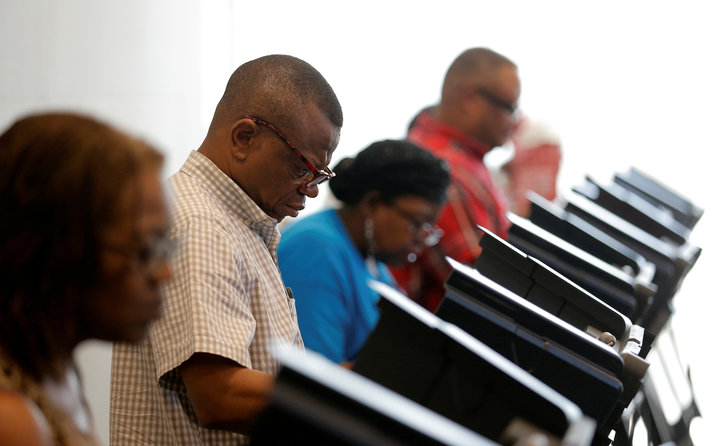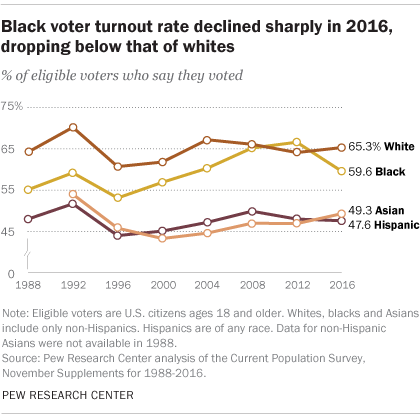
Pew Research Center
A record 137.5 million Americans voted in the 2016 presidential election, according to new data from the U.S. Census Bureau. However, the black voter turnout rate declined for the first time in 20 years in a presidential election, falling to 59.6 percent in 2016 after reaching a record-high 66.6 percent in 2012.
A few long-standing trends in presidential elections either reversed or stalled in 2016, as black voter turnout decreased, white turnout increased and the nonwhite share of the U.S. electorate remained flat since the 2012 election. Here are some key takeaways from the Census Bureau’s report, the data source with the most comprehensive demographic and statistical portrait of U.S. voters.
The 7-percentage-point decline in voter turnout rate from the previous presidential election is the largest on record for blacks. (It’s also the largest percentage-point decline among any racial or ethnic group since white voter turnout dropped from 70.2 percent in 1992 to 60.7 percent in 1996.)
The number of black voters also declined, falling by about 765,000 to 16.4 million in 2016, representing a sharp reversal from 2012. With Barack Obama on the ballot that year, the black voter turnout rate surpassed that of whites for the first time. Among whites, the 65.3 percent turnout rate in 2016 represented a slight increase from 64.1 percent in 2012.
Overall voter turnout – defined as the share of adult U.S. citizens who cast ballots – was 61.4 percent in 2016, a share like 2012 but below the 63.6 percent who say they voted in 2008.
Blacks, Hispanics, Asians and other racial or ethnic minorities accounted for 26.7 percent of voters in 2016, a share unchanged from 2012. Leading up to the election, the overall eligible voting population was the most racially and ethnically diverse ever. However, whites made up 73.3 percent of voters in 2016, a share unchanged from 2012, when they accounted for 73.7 percent.
Meanwhile, blacks made up 11.9 percent of voters in 2016, down from 12.9 percent in 2012 – the first time since 2004 that blacks have declined as a share of voters. Hispanics have accounted for a growing share of the electorate for decades, and this trend continued in 2016, when they made up 9.2 percent of voters, up from 8.4 percent in 2012. Asians made up 3.6 percent of all voters in 2016, up from 2.8 percent in 2012.
The voter turnout rate increased among Millennials and those in Generation X. Millennials (those ages 18 to 35 in 2016) had a 49.4 percent voter turnout rate in 2016, up from 45 percent in 2012 when they were ages 18 to 31. Their turnout rate increased across racial and ethnic groups, with the exception of black Millennials, 49.4 percent of whom turned out in 2016, compared with 55 percent in 2012. This increase in the Millennial voter turnout rate is not only because the generation has grown older (older voters vote at higher rates than younger voters), but also due to a higher turnout rate among its youngest members: 43 percent of 18- to 24-year-olds voted in 2016, up from 41.2 percent in 2012.
Turnout for Generation X (those ages 36 to 51 in 2016) was 62.6 percent, up from 59 percent in 2012. By contrast, the voter turnout rate among older generations was flat. Turnout for Baby Boomers (those 52 to 70) was 68.7 percent in 2016, compared with 68 percent in 2012, while among the Silent and Greatest generations (those 71 and older), it was 70.1 percent in 2016, compared with 71 percent in 2012.
Overall voter turnout – defined as the share of adult U.S. citizens who cast ballots – was 61.4 percent in 2016, a share like 2012 but below the 63.6 percent who say they voted in 2008.





